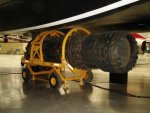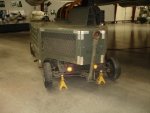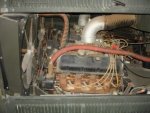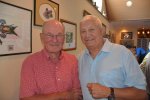I might add, some of you are confusing the SR-71 Blackbird with the A-12 Oxcart. Of course similar, but indeed different planes with different missions and characteristics as well as history. Much of the A-12 program remains classified.
Missions were actually pretty similar, which is why a nearly-identical airplane was used for both. CIA provided all the seed money and startup contracts for the U-2 and, when they became vulnerable, project Oxcart.
Project Oxcart was an enormous technological risk. The U-2 did exotic things, but was a pretty straightforward step from the work that led to the RB-57F. It was made of normal materials and, except for an extra engine compressor stage, weird fuel, and lots of crew life-support, was a pretty straightforward piece of engineering. Probably the most exotic piece of technology on the entire U-2 (during its CIA days) was Dr. Land's camera.
Not so the blackbird: Chief engineer and Skunk Works boss Kelly Johnson's memoirs mention that they were initially considering liquid hydrogen as fuel and built the world's largest (at the time) liquid hydrogen plant to make enough fuel to test with, before they eventually decided on a more conventional hydrocarbon fuel (the same stuff that fueled the U-2, later known as JP-7) and the complex, exotic, and fussy beast that eventually was knows as the Pratt & Whitney J-58.
Basically nothing on a blackbird, any blackbird, was available as a stock item when the plane was designed. Hydraulic fluid, structural materials, paints, fasteners, glass, even the tires were all specially made parts for this one airplane. Nobody knew how many Oxcarts were to be built (the initial order was for 12), but it might be as few as five. Dr. Land's new-and-improved camera tied into the navigation computer was now one of the least exotic components of the essentially hand-built airplane.
If you give the 1960 US DOD the mission of developing strategic reconnaissance information with an airplane they come up with something like an RB-57F or maybe an RF-104. They can't justify (to Congress or to the executive branch Secretaries) the stupid amounts of money required to build the infrastructure the blackbird requires, never mind the amount of money required to build the plane itself.
CIA had fewer masters, a narrower mission, and their budget was opaque to most of Washington and essentially all the USA. If Oxcart failed, few would ever know.
But Oxcart didn't fail, and Lockheed was now in the position of being tooled up to produce the worlds fastest airplane. They sold USAF three of them in the initial production run as fighter interceptor prototypes. They added a weapons operator cockpit and a missile bay beside the nose landing gear: the AF-12/YF-12A. After flight testing, USAF put production orders in for 93 F-12s. Sec. Def. McNamara sat on approving the order for three years and eventually cancelled it in 1968 because the Viet Nam war was too expensive and air breathing bombers were a steadily decreasing threat compared to ICBMs and SLBMs. I've often wondered what our tactical air assets would be like today if USAF had bought 96 F-12s between 1966 and 1969. The blackbird was, among other things, shockingly stealthy by the standards of its era. It would have been a game changer if TAC could have kept it in the air. There was also very brief talk of a bomber variant...
The YF-12 was heavier and a little slower and lower than the A-12 because of its additional weight. USAF and Lockheed had trouble selling it to Washington as the ultimate air defense fighter because it was so expensive and exotic, but figured out that the F-12 was a dandy reconnaissance platform with a lot of payload space that somebody else (CIA) had paid all the R&D costs on. Enter the RS-71 (there was a political fight over the name of the thing during the 1968 election, SR-71 was the second name) Total production was about 30 units, compared to the 15 CIA Oxcarts (the three YF-12s were also built under the Project Oxcart program). Further, CIA was proving about then that, while they were pretty good at spying, they weren't so good at managing very exotic airplanes doing exotic things. The A-12s and M-21s had many more casualties (aircraft and crew) per flight hour than USAF had with their blackbirds. USAF also owned the tankers that were vital to the blackbird's operations. In 1968, Project Oxcart was shut down and its assets went to USAF. The only CIA oxcart that flew USAF recon missions that I know of is the mutant built of half of a test article and half of an A-12 that had a bad landing - it was finished out as an SR-71 and went to work.
The power carts originally had hot-rod Buicks to start the blackbird's engines. These were worn out with years of use, so they were reengined with hot-rodded 454 Chevies. Always tubular headers and nary a muffler in sight. I can confirm that the power carts were an item of pride among the habus just like the airplane itself was - they were always shiny with great paint jobs and bright chrome on the engines and part of the SR-71 experience was definitely the light and sound show of an engine start.






